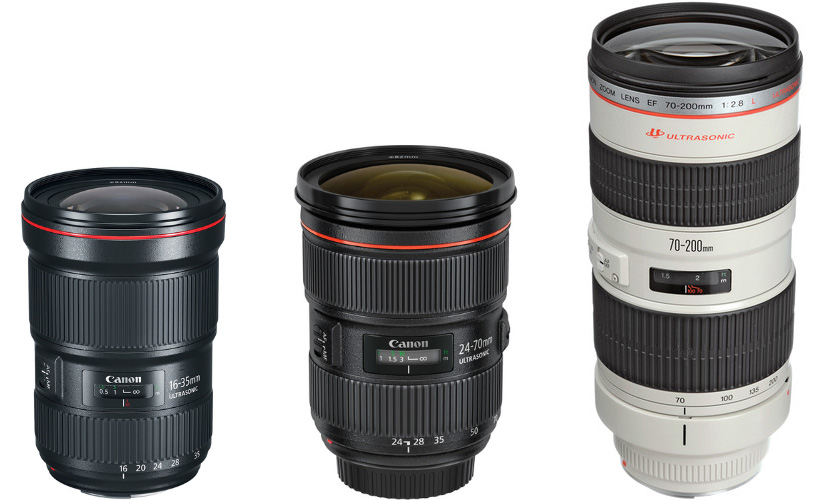When you’re starting your professional career as a photographer and first starting to make some money, it can be hard to decide what pieces of professional gear you should purchase first. After 5 years as a professional wedding photographer, I can reflect back on how I started and the mistakes I made with my first purchases. When I was starting, everyone was talking about the incredible wide aperture primes that were out there, and so I gravitated to them first. The wide open aperture let in lots of light and provided gorgeous bokeh, but the lenses also lacked versatility. I often found myself shooting with an 85mm during cocktail hour only to have a group of people stop me and ask to take a shot of them. I had two options, run and grab a new lens, or try to stand really far back, which wasn’t always a practical option. When you’ve only got a little bit of money to spend, you need to get the most bang for your buck. Zoom lenses allow you to do more with less. They may not have the same character or optical quality of the best primes on the market, but they get the job done. If you’re in the market to upgrade your lenses to some pro gear, you should first start with a couple top quality zooms.
Canon EF 24-70 f/2.8 II

The Canon EF 24-70 f/2.8 L II is a workhorse for professional photographers. With the option of shooting anywhere from wide to zoomed in tight you can shoot everything from landscapes to portraits with this lens. The optical quality is superb, with great sharpness wide open at 2.8. Also, the lens creates gorgeous bokeh at 2.8. While it doesn’t produce the same quality of bokeh that the Canon 50 1.2 L would, it’s plenty considering it’s a zoom. Where this guy shines though is in its versatility. You can get through almost any shoot with this lens on your camera. If you’re a wedding photographer, you can keep it on 90% of the day and your images will be solid all day. The only drawback is its lack of character and its 2.8 aperture.

PROS:
- Versatility
- Very sharp, even wide open
- Great image quality through the range
- Weather sealed
CONS:
- “Only” 2.8 Aperture
- Lacks the character of many prime lenses
- A bit big and heavy, but hey what lens isn’t big and heavy these days?
- It would be nice if it had image stabilization
Check Pricing & Availability Here
Canon EF 70-200 f/2.8 L III

The Canon EF 70-200 2.8 L III is an absolute beast of a lens. Optically it is as close to perfect as a lens can be. If I have a knock against this lens is that it’s almost too perfect. The images from this lens look like the kind of incredible photos you’d see in a newspaper or magazine, probably because this is the lens pretty much every photojournalist clings to, but still. That photojournalistic quality to the lens may or not be a good thing for your specific purposes. That said, nearly every photo I’ve shot with this lens leaves my jaw dropped. If you want to see insane bokeh, shoot this lens at 200mm and f/2.8. The bokeh is ridiculous. It’s also incredibly sharp at f/2.8 and throughout the rest of the aperture range. It keeps chromatic aberration and color fringing to a minimum. This lens can be used by everyone from wedding photographers to sports photographers. Oh, and it also have image stabilization! Yes, it’s big and heavy, but for the versatility and quality you get from this lens, it’s worth it. While I rarely shoot as tight as this lens will go unless I’m in a big church, it’s nice to have it if you need it. With these first two lenses you can shoot almost anything you can imagine.
PROS:
- Very sharp
- Optically incredible
- Gorgeous bokeh
- Weather sealed
- Image Stabilization
CONS:
- It’s really big and heavy
- The images are almost too perfect. Is that really a con?
Check Pricing & Availability Here
Canon EF 16-35 f/2.8 L III

The Canon 16-35 2.8 L III is the best wide angle zoom lens you can buy. It’s plenty sharp wide open and optically excellent. Of course at 16mm it’s going to have some distortion, but at 35mm it’s perfect for a mid range portrait. This is a great lens for shooting everything from landscapes to close ups on the dance floor. If you want to save some money, you can get this guys older brother, the Canon 16-35 L II on Amazon and save yourself a couple hundred bucks. You’ll lose a tiny bit of sharpness wide open, but it’s also an extremely competent wide zoom. If you simply want the best though, go with version III.

PROS:
- Very sharp wide open
- Great versatility
- Excellent image quality
- Weather sealed
CONS:
- Some distortion at the wider end of the lens, but that’s to be expected with a wide angle lens.
- It lacks the character of some of the best wide primes.
Check Pricing & Availability Here
Conclusion
These three lenses make up the “holy trinity” of zoom lenses for Canon DSLR’s. If you’ve got the money and you’re ready to enter the world of truly “pro” lenses then you can’t go wrong by starting with the Canon 24-70 f/2.8 L II. And when you’re ready, the 70-200 and 16-35 are there for you when you need them. More important than new gear though is a solid understanding of how to use that gear. Whether you’re just starting out or you’ve done 100 professional shoots there’s always more to learn. Check out our educational resources to find out how you can take your photography skills to the next level.














